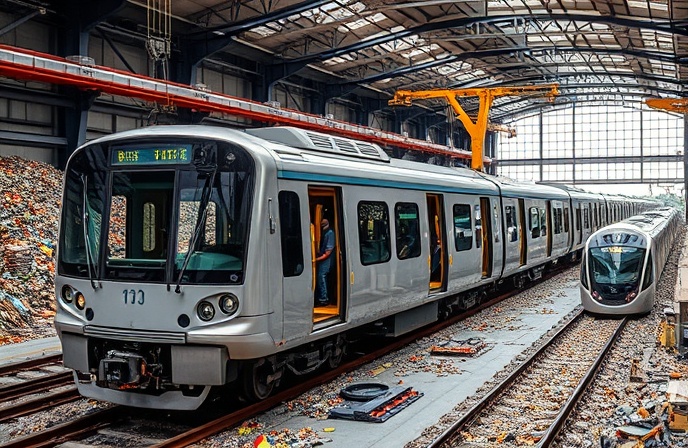LIRR Suffolk County Double Tracking: Project Success
The LIRR’s Suffolk County double-tracking project, completed a year ahead of schedule, proves efficient rail infrastructure development is possible. Discover how strategic planning delivered improved commutes and boosted regional growth!

LIRR’s Suffolk County Double Tracking Project: A Case Study in Accelerated Rail Infrastructure Development
This article examines the Long Island Rail Road’s (LIRR) successful completion of its double-track project in Suffolk County, New York. The project, finished over a year ahead of schedule, serves as a compelling example of efficient project management and its significant impact on commuter rail operations. We will delve into the project’s scope, its engineering challenges, the benefits realized, and the broader implications for future rail infrastructure development. The analysis will highlight the importance of strategic planning, technological advancements, and effective resource allocation in realizing ambitious rail improvement projects. The project’s success demonstrates the transformative potential of infrastructure investment, significantly impacting ridership, economic growth, and overall quality of life in the region. We will explore the detailed aspects of the project, from initial planning and execution to its positive impact on the daily lives of thousands of commuters.
Project Scope and Engineering Challenges
The LIRR’s double-tracking project encompassed thirteen miles of track between Farmingdale and Ronkonkoma, a heavily utilized section carrying approximately 48,000 daily commuters. The project’s scope extended beyond mere track duplication. It involved the installation of a new signaling system, modifications to existing electrical substations, and the implementation of a new third-rail electrical system to power the additional tracks. This comprehensive approach aimed to enhance not only capacity but also the reliability and safety of the rail line. The integration of these various systems presented significant engineering challenges, requiring precise coordination and meticulous planning to minimize disruption to existing services. The successful navigation of these challenges underscores the importance of robust project management and experienced engineering teams.
Phased Implementation and Early Completion
The project was executed in phases, with the first phase, encompassing the Ronkonkoma to Central Islip section, completed in August 2016. This phased approach allowed for incremental improvements while mitigating potential widespread service disruptions. The project’s overall completion more than a year ahead of schedule is a testament to efficient planning, streamlined execution, and effective resource management. The early completion not only benefited commuters with improved services sooner than anticipated but also freed up resources for other critical rail infrastructure projects in the region. This showcases the advantages of proactive project management and a focus on optimizing timelines and budgets.
Benefits and Impacts
The double-tracking project has yielded substantial benefits. The most immediate impact is a significant reduction in delays and congestion along this critical section of the LIRR. This improvement directly translates into a more reliable and predictable commuting experience for tens of thousands of daily passengers. The increased capacity enabled the immediate introduction of reverse-peak services, providing enhanced morning and evening commuting options for riders. Furthermore, the upgraded infrastructure includes improved station amenities, such as new platforms at Wyandanch Station accommodating 12-car trains, complete with snow-melt systems, pedestrian overpasses with elevators, and improved shelters. These enhancements not only improve the passenger experience but also contribute to the overall attractiveness and efficiency of the rail system.
Conclusion and Future Implications
The LIRR’s double-track project in Suffolk County stands as a remarkable achievement in rail infrastructure development. Its successful completion ahead of schedule highlights the benefits of strategic planning, meticulous execution, and effective resource management. The project’s impact extends beyond mere capacity improvements; it has significantly enhanced the reliability, safety, and overall passenger experience on the LIRR. The availability of freed-up resources allows for accelerated progress on other critical initiatives, such as the East Side Access expansion, the Main Line third track, and the Mid-Suffolk Train Storage Yard. This demonstrates a cascading effect of successful infrastructure projects, leading to a more comprehensive and efficient rail network. The project’s success serves as a model for other ambitious rail projects, emphasizing the importance of holistic planning, technological advancements, and a commitment to delivering high-quality results. It underscores the transformative potential of investment in rail infrastructure, positively impacting commuters, economic development, and the overall quality of life in the region. The enhanced capacity, improved reliability, and expanded service options provided by the double-tracking project exemplify the significant benefits of proactive investment in modernizing and expanding commuter rail systems. The lessons learned from this project can be invaluable in guiding future initiatives aimed at improving the efficiency, reliability, and passenger experience on other commuter rail lines across the country and the globe.



